Haying With a Compact Tractor
TBN | Posted on |
If you’ve got a large pasture and want to get a productive hay crop growing, there are a few steps to take. Don’t think that just because you don’t have a big ag tractor you can’t get in on the haying game. We’ll try to help steer you in the right direction with this article on haying with a compact tractor.
Seeding
First, you’ll want to decide how serious you’re going to take haying. If you’re considering investing in equipment and using your hay for your livestock or even selling it locally, seeing your field with an appropriate mix of seeds for your livestock and region will be necessary. There are many resources online that cover this topic, including this article by the USDA: Specification & Guide Sheet For Pasture & Hay Planting
For seeding a new field, a seed drill should be in your arsenal. Finding a small one or even an older unit could get you started on a budget. Here’s a nice setup by Flusher in Sacramento: A restored Minneapolis Moline P3-6 drill (10 ft wide, 20 drops, single disc openers):


Drill vs No-Till Drill
Just as the name suggests, a no-till drill enables you to drill seeds into the ground without tilling. Lots of commercial farmers are going this route as it has a number of advantages over tillage. Without getting into that debate, here’s an example of a nice Landpride 606NT Drill w Grain, Small Seed & Native Grass Boxes:

Whether investing in a seeding drill will make sense will depend on how much land you’ll be planting. For most small scale homeowner operations, simply mowing and baling an existing pasture is more aligned with their goals and budget. Crops like alfalfa only need to be re-planted every five years or so, and can be cut every 28 days. Owning a drill to use once every five years might make the whole project senseless. Perhaps a helpful neighbor or renting the tool you need is the solution for you. Like we said, it will depend on your overall farming objectives.
“Did somebody say hay? I’m hungry”

Keep your eye on the prize. You don’t grow horns like this eating sub-standard hay!
Mowing
Now, let’s get into the essential tools required for haying with a compact tractor. First, you need a pasture. Okay, got that. Now you need to mow it. The most popular type of mowers for fields are disc or drum mowers. They come in many sizes, including small units to run on a compact tractor. Either type is a good choice as they both cut by shearing the stem of the grass. The drum mower is usually used on large compact tractors or utility tractors, but some drum mowers are made for tractors as low as 15 PTO horsepower. The drum mower is preferred by compact tractor owners not just because they come small enough to fit a compact tractor, but also for durability, simplicity, and a price that is accessible.
Disc mowers are typically found in larger sizes—5 1/2′ to 10 1/2′ cutting width—with prices starting a bit higher than drum mowers. If you want a larger cut then the disc mower is usually the way to go. All but the smallest disc mowers require 40 HP or more so keep that in mind if you have a small tractor.
Mower-Conditioner
Most drum mowers have built-in rollers that condition (crimp) the stalks of grass every few inches to break open the stalk and allow moisture to escape. This accelerates the evaporation of moisture inside the stalk and is part of the drying process. The conditioner then drops the grass in windrows.
What’s a Windrow?
A windrow is a row of cut hay or grain crop. As it lays cut, it dries before being baled. For hay, the windrow is first formed by a mower and then by a hay rake.
Mowers in Action
Here’s a video of a small John Deere with 15 PTO horsepower cutting hay with a drum mower:
This video shows the Yanmar YMDM50 disc mower in action:
Cutting Width vs Cutting Speed
Both cutting width and cutting speed will determine how long it will take to mow, and the size and speed will be limited by your tractor’s horsepower. More horsepower with a smaller mower means you can mow at higher speeds, which increases your productivity as much or more than a wider cut, but without the downsides of added weight of the larger mower. There’s no sense trying to run a wider mower than your machine can handle, as that’s going to bog your tractor down and may even cause damage to your equipment. There are some general guidelines on disc mower sizes published by mower manufacturers that you can consult when buying a mower. Some tractor manufacturers also list disc mower sizes in tractor operator’s manuals, so check there too.
Stability When Mowing
Don’t forget things like counter-balance, and whether your field has hills. Mowing up hill will put the tractor engine under load. You will want to stay within a mower size that can handle all conditions you’re going to mow under. The same goes for balance; will you be mowing on hills? If so, some counter weights are going to be in order.
Here’s an example of a small drum mower running on an old Ford Jubilee:


Drying & Tedding
After the hay has been cut by the mower of your choice, it will lay in a windrow in the field. The grass on top that is exposed to the sun will dry quicker than the grass that is at the bottom of the windrow, so the solution to dry all of the hay evenly is to use a tedder. This machine will basically spread out the cut grass, lay it flat on the field, so it can dry evenly and completely. Here’s a video that shows how a tedder works:
Raking

After tedding, the next step is raking the hay back into windrows so it can be baled. Here’s a pretty slick all-in-one tedder/rake made by Yanmar:
Baling
Once the grass is fully dry and raked back into windrows, you are ready to bale. While it wasn’t that long ago that running a baler on a tractor smaller than about 60-70 horsepower was impossible, these days there are several good options on the market including the Yanmar round baler and the Abbriata square balers in the videos below. Haying with a compact tractor has never been more accessible or efficient.
Also see our related article: Choosing a Hay Baler For Your Compact Tractor
Balers in Action
Round Baler:
Collecting Hay Bales


Sources for Hay Tools
In addition to your local tractor dealer, here are some places you can buy tools for haying with a compact tractor:


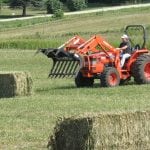


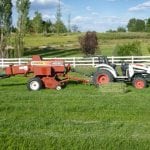
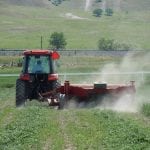




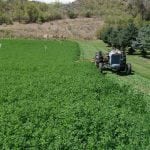




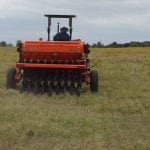


4 Comments
Great article! Enjoyed the informational videos. God bless those who farm…the folks that grow the stuff that allows so many others the opportunity to eat…
Enjoyed the article and the video very much…Would help if you included ball park cost associated.
Excellent articles on compact tractor haying and maintenance were very well done and informative. Bringing insight to who many people who never thought the possibility’s were even available.
The ground driven siclebar was invented by Cyrus McCormick in 1835 so mowing and raking have never needed large amounts of horse power. International invented the square baler in 1921 and a 7 ft wide pickup is supposed to require 35 hp. I use a 47 International square baler behind my 20 hp Nortrac without any problems running the tractor at half throttle (roughly 7 pto hp). The secret is not doubling windrows together.